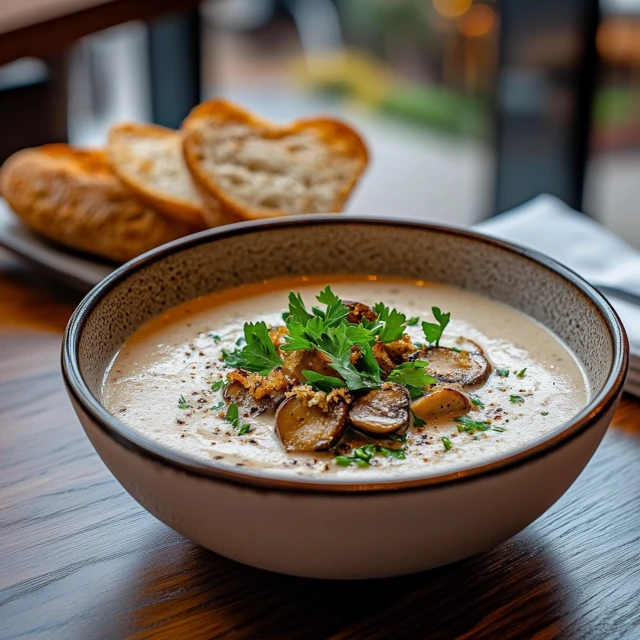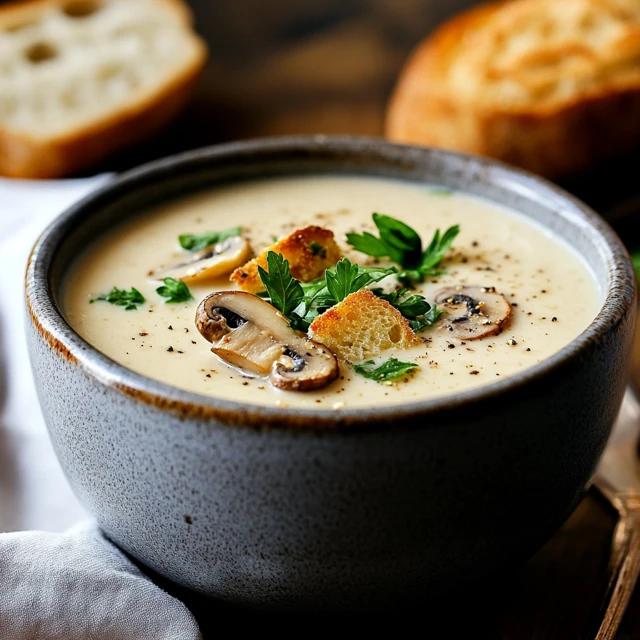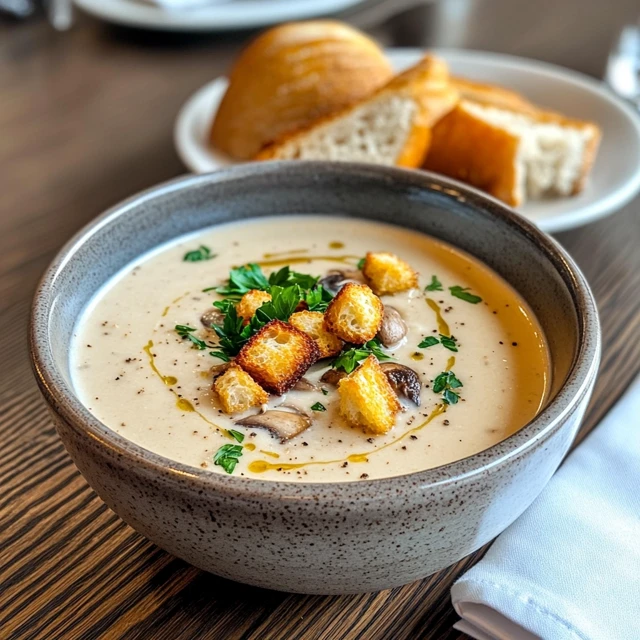Enhancing cream of mushroom soup is a simple yet rewarding process that transforms this timeless classic into a truly gourmet experience. Celebrated for its comforting creaminess and earthy mushroom flavour, cream of mushroom soup can be elevated with thoughtful additions and techniques, whether you’re using a store-bought variety or preparing a homemade version. With just a few key enhancements, you can improve its taste and texture, creating a standout dish that’s perfect for everything from casual lunches to elegant dinner starters. By focusing on flavour balance, texture, and umami depth, you can take cream of mushroom soup from ordinary to extraordinary, delighting even the most discerning palate.
The Versatility of Cream of Mushroom Soup
One of the reasons cream of mushroom soup remains so popular is its versatility. It can be enjoyed as a standalone dish, paired with crusty bread, or used as a rich base for casseroles, sauces, and more.
Store-Bought vs Homemade: Why Enhancements Matter
While homemade cream of mushroom soup allows for greater control over ingredients and flavours, store-bought versions are a convenient option for many. However, even the best store-bought soups often lack the depth and complexity of a homemade version. Enhancements such as fresh herbs, sautéed garlic, or a splash of white wine can elevate the taste, adding a personal touch that bridges the gap between convenience and quality.
Balancing Flavours for a Gourmet Experience
A well-balanced cream of mushroom soup achieves harmony between its creamy richness and the earthy, savoury notes of mushrooms. Adding ingredients like a dash of nutmeg, a hint of lemon zest, or a sprinkle of fresh parsley can brighten the flavours, ensuring the soup doesn’t feel too heavy or one-dimensional. For those who enjoy a more indulgent experience, ingredients like heavy cream or grated Parmesan can add luxurious depth.
Common Challenges in Achieving a Better Taste
Even with high-quality ingredients, certain challenges can hinder the overall quality of cream of mushroom soup. Addressing these issues is key to crafting a truly elevated dish.
Overly Bland Flavour Profiles
One common issue with cream of mushroom soup is a lack of robust flavour. To counter this, incorporate aromatics such as onions, garlic, or shallots at the beginning of the cooking process. Enhancing the umami notes with ingredients like soy sauce, miso paste, or a splash of Worcestershire sauce can also add depth and complexity, transforming the soup into a more dynamic dish.
Issues with Texture: Too Thin or Too Thick
Achieving the right consistency is crucial for an enjoyable soup experience. If the soup is too thin, a slurry of cornstarch or flour and water can help thicken it without compromising the flavour. On the other hand, if the soup is too thick, thinning it with vegetable or chicken stock ensures a smoother, more enjoyable texture while adding flavour.
Lack of Depth in Umami Flavour
Mushrooms are naturally rich in umami, but this can sometimes be lost in preparation. To amplify these savoury notes, consider adding roasted mushrooms, a splash of soy sauce, or even a small amount of truffle oil for a luxurious touch. Cooking the mushrooms until they’re golden brown before incorporating them into the soup also enhances their natural flavour, creating a deeper, more satisfying profile.

Techniques to Make Cream of Mushroom Soup Taste Better
Cream of mushroom soup is a comforting and versatile dish, but with a few expert techniques, you can elevate its flavour and texture to create a truly remarkable culinary experience. From enhancing the mushroom base to adding layers of flavour and achieving the perfect creaminess, these steps will guide you in crafting a soup that’s rich, balanced, and deeply satisfying.
Enhancing the Mushroom Base
The mushrooms are the heart of this soup, and maximising their flavour is essential for a robust and earthy base.
Using Fresh Mushrooms for Superior Flavour
Fresh mushrooms provide a depth of flavour and texture that is unparalleled compared to canned or dried options. Opt for high-quality mushrooms like cremini, button, or shiitake, as they bring a unique richness to the soup. Cleaning them gently with a damp cloth instead of rinsing preserves their flavour and prevents excess moisture, ensuring they sauté beautifully.
Sautéing Mushrooms with Butter or Olive Oil
Sautéing mushrooms in butter or olive oil before incorporating them into the soup enhances their natural umami flavour. Cooking them over medium heat until golden brown develops caramelisation, adding complexity and a slightly nutty undertone to the soup. A pinch of salt during this process draws out their moisture and concentrates their taste.
Combining Multiple Mushroom Varieties for Depth
Using a mix of mushroom varieties creates a multidimensional flavour profile. For example, combining earthy shiitake, meaty portobello, and delicate oyster mushrooms adds layers of richness and texture, resulting in a more sophisticated and nuanced soup.
Elevating the Creaminess
The creaminess of the soup is one of its defining characteristics, and achieving the perfect texture requires attention to detail.
Choosing Quality Dairy Products: Cream, Milk, or Alternatives
Using high-quality dairy products, such as heavy cream or whole milk, ensures a velvety texture and luxurious mouthfeel. For non-dairy options, coconut cream or cashew milk work beautifully, offering creaminess without overpowering the mushroom flavour. Avoid low-fat products, as they can lack the richness needed for a balanced soup.
Thickening with Roux, Cornflour, or Pureed Vegetables
A proper thickener can transform the consistency of cream of mushroom soup. A roux, made by cooking equal parts butter and flour, creates a smooth and stable base. Alternatively, a slurry of cornflour and water can be used for a gluten-free option. For a natural thickening method, blending a portion of the soup with cooked potatoes, cauliflower, or even mushrooms themselves adds body while enhancing flavour.
Avoiding Split or Curdled Sauces
To prevent the soup from splitting or curdling, always add dairy products at the end of the cooking process and ensure the heat is kept low. Gradually temper cream by adding small amounts of warm soup before incorporating it fully, which stabilises the mixture and ensures a silky texture.

Adding Layers of Flavour
Flavourful additions can take cream of mushroom soup to the next level, creating a depth that keeps each spoonful exciting and satisfying.
Aromatics: Garlic, Shallots, and Onion
Aromatics form the foundation of a flavourful soup. Sautéing garlic, shallots, and onions in butter or olive oil at the beginning of the cooking process releases their natural sweetness and enhances the overall flavour. Shallots, in particular, add a subtle, sophisticated sweetness that complements the mushrooms beautifully.
Herbs and Spices: Thyme, Rosemary, or Nutmeg
Herbs and spices elevate the taste of cream of mushroom soup, adding layers of complexity. A sprig of fresh thyme or rosemary infuses the soup with earthy, fragrant notes, while a pinch of nutmeg highlights the creamy elements with a warm, subtle sweetness. Adding these ingredients sparingly ensures they enhance rather than overpower the mushrooms.
Umami Boosters: Soy Sauce, Worcestershire, or Miso Paste
For a richer, savoury flavour, incorporate umami-enhancing ingredients. A splash of soy sauce or Worcestershire sauce deepens the soup’s profile, while a teaspoon of white miso paste adds a gentle, fermented tang. These additions amplify the natural umami of the mushrooms, making the soup more dynamic and satisfying.
Final Touches and Serving Tips
Cream of mushroom soup can be elevated to a culinary masterpiece with the right finishing touches, thoughtful pairings, and a few customisations. Garnishing adds visual appeal and textural contrast, while pairing the soup with complementary dishes creates a well-rounded meal. Customising the recipe with proteins or seasonal vegetables allows for variety, and proper storage and reheating techniques ensure the soup remains just as delightful the next day. These final steps ensure your soup is as impressive in presentation as it is in flavour.
Garnishing for Appearance and Texture
Garnishes not only make the soup visually appealing but also enhance the overall eating experience by adding layers of texture and flavour.
Fresh Herbs like Parsley or Chives
A sprinkle of freshly chopped parsley or chives brightens the soup with their vibrant green colour and mild, herby notes. Parsley adds a clean, peppery flavour, while chives bring a subtle onion-like freshness that complements the richness of the soup without overpowering it.
Crunchy Toppings: Croutons, Fried Shallots, or Toasted Nuts
Adding a crunchy element like golden croutons, crispy fried shallots, or toasted nuts provides a delightful contrast to the creamy texture of the soup. The crunch not only enhances the sensory experience but also introduces new flavours, such as the nutty warmth of toasted almonds or the savoury crispness of shallots.
Drizzling with Truffle Oil, Cream, or Olive Oil
A light drizzle of truffle oil infuses the soup with a luxurious, earthy aroma, while a swirl of cream adds visual elegance and extra indulgence. Alternatively, a splash of high-quality olive oil introduces a fruity richness that rounds out the flavours beautifully.

Pairing with Complementary Dishes
Pairing cream of mushroom soup with simple yet complementary dishes creates a balanced and satisfying meal.
Rustic Bread, Garlic Toast, or Breadsticks
The hearty, creamy nature of the soup pairs perfectly with rustic bread, garlic toast, or crunchy breadsticks. Warm, crusty bread is ideal for dipping, while the garlicky flavour of toast enhances the savoury notes of the soup. Breadsticks offer a crisp, fun-to-eat accompaniment that contrasts the soup’s smooth texture.
Simple Salads or Roasted Vegetables
A light salad, such as a mixed greens or arugula salad with a tangy vinaigrette, balances the richness of the soup with its refreshing crunch. For a heartier pairing, roasted vegetables like carrots, parsnips, or Brussels sprouts bring a caramelised sweetness that complements the earthy mushroom flavour.
Customising the Recipe
Customising cream of mushroom soup allows you to adapt it to suit various tastes and dietary preferences, making it a versatile dish for any occasion.
Adding Proteins: Chicken, Beef, or Tofu
Incorporating proteins like shredded chicken, crispy beef, or pan-fried tofu transforms the soup into a more substantial meal. Chicken adds a tender, savoury element, beef contributes smoky saltiness, and tofu offers a plant-based protein option that absorbs the soup’s rich flavours.
Incorporating Seasonal Vegetables: Spinach, Kale, or Carrots
Seasonal vegetables bring colour, nutrition, and flavour to the soup. Fresh spinach or kale can be stirred in at the end for a pop of green and added texture, while finely diced carrots introduce a touch of natural sweetness that balances the savoury base.
Storage and Reheating Tips
Storing and reheating cream of mushroom soup requires care to preserve its creamy texture and full flavour.
Maintaining Texture When Reheating
When reheating, use low to medium heat and stir frequently to prevent the soup from scorching or separating. Adding a splash of milk, cream, or broth can help restore its original consistency, ensuring the texture remains smooth and velvety.
Freezing Cream-Based Soups Correctly
To freeze the soup, let it cool completely before transferring it to an airtight container. Avoid adding cream before freezing, as dairy tends to separate when thawed. Instead, add the cream during reheating for a fresher and more cohesive texture.
Reheating Without Splitting or Overcooking
Reheat the soup gently on the stovetop, avoiding high heat to prevent the dairy from splitting. Gradually warm the soup while stirring continuously, and temper the cream by mixing it with a small amount of warm soup before fully incorporating it to avoid curdling.

